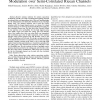Free Online Productivity Tools
i2Speak
i2Symbol
i2OCR
iTex2Img
iWeb2Print
iWeb2Shot
i2Type
iPdf2Split
iPdf2Merge
i2Bopomofo
i2Arabic
i2Style
i2Image
i2PDF
iLatex2Rtf
Sci2ools
103
click to vote
TCOM
2010
2010
Receive antenna selection for unitary space-time modulation over semi-correlated Ricean channels
—Receive antenna selection for unitary space-time modulation (USTM) over semi-correlated Ricean fading channels is analyzed (this work generalizes that of Ma and Tepedelenlio˘glu for the independent and identically distributed (i.i.d.) Rayleigh fading case). The antenna selection rule is that the receive antennas with the largest signal powers are chosen. For single antenna selection, we derive the maximum likelihood decoding for the correlated Ricean case. We also derive the Chernoff bound on the pairwise error probability for the high signal-to-noise ratio (SNR) region and obtain the coding gain and diversity order. Our results show that even when there are transmitter side correlations and a line of sight component, receive antenna selection with USTM preserves the full diversity order if the USTM constellation is of full rank. We also give an approximation to the distribution function of a quadratic form of non-zero mean complex Gaussian variates (from Nabar et al.) at the high ...
| Added | 30 Jan 2011 |
| Updated | 30 Jan 2011 |
| Type | Journal |
| Year | 2010 |
| Where | TCOM |
| Authors | Mahdi Ramezani, Mahdi Hajiaghayi, Chintha Tellambura, Masoud Ardakani |
Comments (0)

